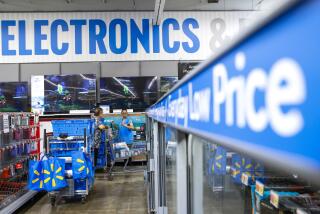U.S. growth is strongest in a decade

The U.S. is rolling into the new year with impressive strength as plunging oil prices have ignited consumer spending and helped fuel the best stretch of growth in more than a decade — even as economies around the world are struggling.
A basketful of mostly upbeat economic data Tuesday pushed financial markets to record highs, with the Dow Jones industrial average breaking through the 18,000-point barrier for the first time.
Investors were spurred by a Commerce Department report that the U.S. economy expanded at a remarkable 5% annual rate in the third quarter, the fastest pace since 2003 and a far cry from the tepid growth that has plagued most of the recovery from the Great Recession.
“This is literally shoot-the-lights-out sort of stuff,” said Chris Rupkey, chief financial economist at Union Bank in New York. “This economy is pretty much roaring.”
And the third quarter wasn’t a fluke.
Total economic output, also known as gross domestic product, expanded at a 4.6% annual rate in the second quarter. It marks the first time the economy posted back-to-back quarters of more than 4.5% growth since 2003.
Economists don’t expect the torrid pace to continue. The fourth quarter will probably keep the positive momentum, but at a more modest 2.5% to 3%.
With gasoline prices plummeting, Americans are feeling the difference in their bank accounts. Consumer spending jumped in November as incomes continued to rise.
And with a leading measure of consumer confidence on Tuesday hitting its highest level since 2007, signs point to strong spending carrying into next year, economists said.
“The U.S. economy prior to the oil price decline was doing reasonably well. It was chugging along,” said Brian Bethune, chief economist at Alpha Economic Foresights.
“Then we get an accelerator, which is the drop in oil prices,” he said. “It’s equivalent to a big tax cut — and the tax cut is getting larger.”
Although oil prices rose Tuesday — partly because strong U.S. growth signaled increased demand — they have fallen nearly 50% over the last six months.
That’s caused the average price for a gallon of regular to drop to $2.38 a gallon, according to AAA. That’s down 15 cents in just a week and 87 cents from a year ago.
The savings at the gas pump have boosted consumer spending, which rose 3.2% in the third quarter. Those figures beat an earlier estimate, and rose from 2.5% in the previous quarter. A big factor was an increase in spending on healthcare.
The stronger consumer spending was a key reason the Commerce Department revised up growth for the third quarter from an estimate last month of 3.9%.
Consumers are the main driver of the economy. And their spending accelerated in November, increasing 0.6% from the previous month for the biggest jump since summer.
“Consumers are the front engine for all of this,” said Robert Johnson, director of economic analysis for Chicago mutual-fund research firm Morningstar Inc.
Growth also received a boost from federal government expenditures, which surged 9.9%. Much of that was military spending related to the battle against Islamic State fighters in Iraq and Syria. Economists don’t expect that level of spending to continue.
Business investment was strong as well, rising 8.9% in the third quarter.
U.S. financial markets rose only modestly Tuesday because stocks had already been surging in recent days on stabilizing oil prices and news that the Federal Reserve would be patient in raising interest rates, he said.
Still, the blue-chip Dow was up 64.73 points, or 0.3%, to 18,024.17, a record high. And the broad-based Standard & Poor’s 500 index was up 3.63 points, or 0.2%, to 2,082.17, also a record close.
Investors have been warily watching the Federal Reserve, which has indicated that it would raise short-term interest rates from near zero next year as the economy heats up.
Many on Wall Street expect the first rate hike to come in June, or even later, on the belief that Fed Chairwoman Janet L. Yellen and a majority of the committee will be cautious in raising rates for the first time since 2006.
Yellen has signaled the Fed will take into account the effect of its moves not just on the U.S. but on fragile economies overseas. And there are a lot of them.
Japan has fallen back into recession, the 18-nation Eurozone is on the brink of one, and China’s economy has been slowing.
“Janet Yellen understands that what she does affects not only the U.S. but other parts of the world,” said Alan Whitman, a Morgan Stanley managing director.
Despite those worldwide problems, the U.S. economy is humming along.
“The U.S. is cranking on all cylinders when it comes to its own internal demand,” Rupkey said. “All those fears that the U.S. could not remain an oasis of prosperity when world growth is slowing was simply untrue.”
Although U.S. exporters are hurt by slowing global demand, consumer spending accounts for about 70% of domestic growth. And consumers, flush with savings from cheaper gas and energy, are more than making up the difference.
Economists forecast U.S. growth next year could hit 3%, which would be a milestone after the Great Recession.
Despite the boom from spring through fall, a weak first quarter caused by severe weather dragged down overall annual growth this year to about 2.5%.
“At 3% growth, we start to see the economy growing faster than its potential and make up much more of the losses from the Great Recession,” said Doug Handler, chief U.S. economist at IHS Global Insight.
More to Read
Inside the business of entertainment
The Wide Shot brings you news, analysis and insights on everything from streaming wars to production — and what it all means for the future.
You may occasionally receive promotional content from the Los Angeles Times.











